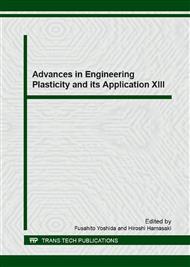p.208
p.214
p.220
p.226
p.232
p.238
p.243
p.249
p.255
High Temperature Deformation of Cast ZW11 Magnesium Alloy with Very Large Grain Size
Abstract:
Magnesium (Mg) alloys are considered for biomedical applications due to their matching bone density and biodegradable/abioabsorable nature. Mg-1% Zinc-1% Yttrium (ZW11) alloy was cast using a direct chill slow cooling process to obtain dense ingot with uniform composition. However, the resultant alloy developed a very coarse grained microstructure with a grain size in the range of 2,600 to 4,000 μm (2.6-4.0 mm). The hot working behavior of ZW11 alloy has been investigated using compression tests in the temperature and strain rate ranges of 340-540 °C and 0.0003 – 10 s-1 to evaluate the optimum processing parameters. A processing map has been developed on the basis of the flow stress data. The processing map reveals a window of workability in the temperature and strain rate ranges of 460-540 °C and 0.0003-10 s-1 and regimes of flow instability. The microstructures of the deformed alloy provided support to the processing map.
Info:
Periodical:
Pages:
232-237
Citation:
Online since:
December 2016
Authors:
Keywords:
Price:
Сopyright:
© 2017 Trans Tech Publications Ltd. All Rights Reserved
Share:
Citation:


